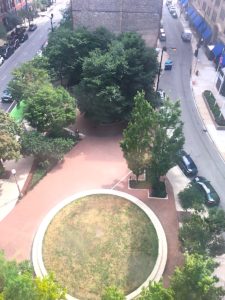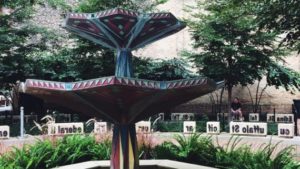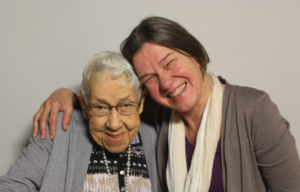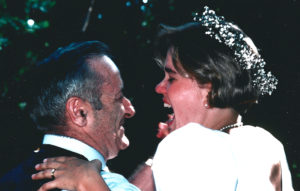A Visit to the Pullman Monument, and Wanda on StoryCorps Tonight
August 26, 2021 • Comments • Posted in blindness, politics, teaching memoir, technology for people who are blind, writingMy friend Bill Green can see a little bit. I can’t see at all. The two of us have known each other for years, and a trip to Chicago’s Pullman neighborhood three weeks ago marked the first time we’ve actually worked together.
If you call getting a personal tour of Chicago’s new Pullman National Monument work, that is.
Let me explain. After learning of our involvement with the Chicago Cultural Access Consortium, The President & CEO of Museum Partners in Virginia emailed each of us, introducing herself as a museum consultant. She said she was working with an exhibit fabrication firm, and that firm had created an audio-described tour for the Visitor’s Center at the National Park Site.
”They would like it tested by two people,” she said, explaining that the site would be having its grand opening on Labor Day this year ,and they needed one tester to have low vision, the other to be totally blind. “They primarily want feedback on the directional aspect of the tour, she wrote. “But any feedback is welcome.”
Exhibit fabrication? Museum consultant? “Directional aspect” of a tour? I had no idea what those words meant, but I knew I qualified in the “totally blind” category. And once I got to the part of the note that said, “We will provide lunch,” I was in. During our six hours there, I learned :
- How the U.S. National Park Service ended up opening a site in Chicago’s historic Pullman neighborhood, (President Obama designated Pullman as a National Monument on February 19, 2015)
- Pullman was the first model, planned industrial community in the United States
- In its time, Pullman Company was one of the most famous company towns in the United States, and
- In the late 19th century, Pullman was the scene of the violent 1894 Pullman strike.
My ability to retain all that information three weeks after my visit supports the idea that the “directional aspect” of the tour works, don’t you think?! Before our visit, all I really knew about Pullman was that they were the ones who hired the Pullman Porters, the sleeping car porters Wanda bridgeforth talks about in stories she writes for our “Me, Myself & I” memoir-writing class. Pullman was the largest employer of Blacks in the country when she was a kid, and the greatest concentration of Pullman porters lived in the neighborhoods she’d grown up in on Chicago’s South Side. “Pullman only hired Black’s as Porters,” she told me, and on my visit to the national site I learned that, in its heyday, Pullman was the nation’s largest employer of African Americans.
What? Pullman had strong beliefs in social justice? Afraid not. He’d simply reasoned that newly-freed slaves and their sons and grandsons would make excellent servicemen who would work for long hours at little pay. Exhibits at the national site talk about the formation of the Brotherhood of Sleeping Car Porters and how they became the first Black labor union in the United States chartered under the American Federation of Labor, an extremely important step in African American Civil Rights.
That I have retained a lot of what I learned at the Pullman Porter exhibits should tell you the audio description was pretty good, too. Still, most of what I know specifically about the Pullman Porters comes directly from Wanda Bridgeforth.
Wanda’s father and her five uncles grew up near the train station in Jackson, Mississippi, and Wanda writes how the Pullman Porters’ practice of bringing copies of The Defender, — Chicago’s Black weekly — encouraged her relatives to migrate north (they’d find out about available jobs and housing in Chicago by reading the paper).
Porters were happy to deliver goods from the south to friends and family north of the Mason-Dixon line, too. Wanda loves to share how her Grandma Lula Johnson in Jackson would regularly bake birthday cakes for her offspring in Chicago and send them north with a porter. Wanda’s favorite uncle, Hallie B., would head to Chicago’s 12th Street Station on every birthday, collect the cake, and hand-deliver it to the birthday party here in Chicago. “The porters all knew my Grandma Lula,” Wanda laughs.
The National APR Pullman Porter Museum at the National Pullman Monument is dedicated to African American labor history. My time at the National Pullman Monument reminded me what a privilege it is to learn history directly from the people who lived it. Like Wanda.
PS: At 6 p.m. tonight (Thursday, August 26) you can Zoom in and hear a 2018 StoryCorps Chicago conversation I had with Wanda Bridgeforth followed by a live Q&A with emcee Nestor Gomez asking me about my friendship with her. All free of charge, and all part of the StoryCorps Chicago Listening Event Finale tonight from 6 pm to 7:30 pm. Tune in!



 I’ve always thought “Field of Dreams” was kind of a bad movie with some irresistible features.
I’ve always thought “Field of Dreams” was kind of a bad movie with some irresistible features.